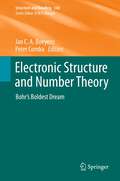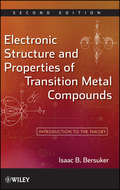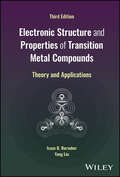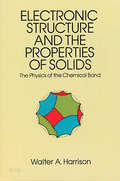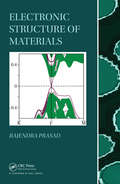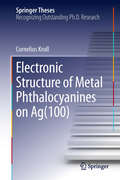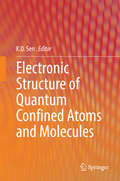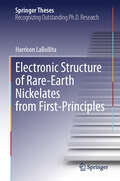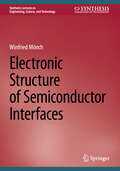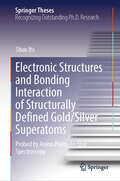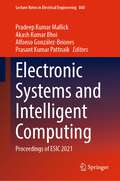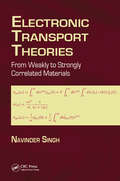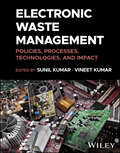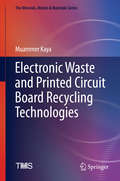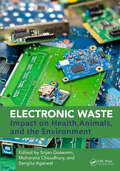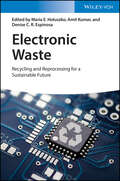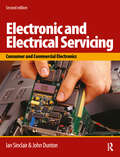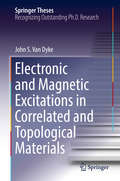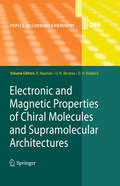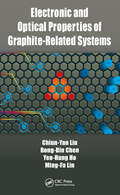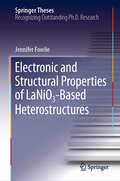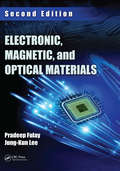- Table View
- List View
Electronic Structure and Number Theory
by Peter Comba Jan C.A. BoeyensThe series Structure and Bonding publishes critical reviews on topics of research concerned with chemical structure and bonding. The scope of the series spans the entire Periodic Table and addresses structure and bonding issues associated with all of the elements. It also focuses attention on new and developing areas of modern structural and theoretical chemistry such as nanostructures, molecular electronics, designed molecular solids, surfaces, metal clusters and supramolecular structures. Physical and spectroscopic techniques used to determine, examine and model structures fall within the purview of Structure and Bonding to the extent that the focus is on the scientific results obtained and not on specialist information concerning the techniques themselves. Issues associated with the development of bonding models and generalizations that illuminate the reactivity pathways and rates of chemical processes are also relevant. The individual volumes in the series are thematic. The goal of each volume is to give the reader, whether at a university or in industry, a comprehensive overview of an area where new insights are emerging that are of interest to a larger scientific audience. Thus each review within the volume critically surveys one aspect of that topic and places it within the context of the volume as a whole. The most significant developments of the last 5 to 10 years should be presented using selected examples to illustrate the principles discussed. A description of the physical basis of the experimental techniques that have been used to provide the primary data may also be appropriate, if it has not been covered in detail elsewhere. The coverage need not be exhaustive in data, but should rather be conceptual, concentrating on the new principles being developed that will allow the reader, who is not a specialist in the area covered, to understand the data presented. Discussion of possible future research directions in the area is welcomed.
Electronic Structure and Properties of Transition Metal Compounds: Introduction to the Theory
by Isaac B. BersukerWith more than 40% new and revised materials, this second edition offers researchers and students in the field a comprehensive understanding of fundamental molecular properties amidst cutting-edge applications. Including ~70 Example-Boxes and summary notes, questions, exercises, problem sets, and illustrations in each chapter, this publication is also suitable for use as a textbook for advanced undergraduate and graduate students. Novel material is introduced in description of multi-orbital chemical bonding, spectroscopic and magnetic properties, methods of electronic structure calculation, and quantum-classical modeling for organometallic and metallobiochemical systems. This is an excellent reference for chemists, researchers and teachers, and advanced undergraduate and graduate students in inorganic, coordination, and organometallic chemistry.
Electronic Structure and Properties of Transition Metal Compounds: Theory and Applications
by Isaac B. Bersuker Yang LiuPresents the latest achievements in the theory of electronic structure and properties of transition metal coordination compounds with applications to a range of chemical and physical problems Electronic Structure and Properties of Transition Metal Compounds offers a detailed and authoritative account of the theory of electronic structure and the properties of transition metal compounds with applications to various chemical and physical problems. The fully updated third edition incorporates recent developments and methods in the field, including new coverage of methods of ab initio calculations of the electronic structure of coordination compounds and the application of vibronic coupling and the Jahn-Teller effect to solve coordination chemistry problems. Revised chapters provide up-to-date views on reactivity, chemical activation, and catalysis. New and expanded questions, exercises, and problems in each chapter are supported by new problem-solving examples, illustrations, graphic presentations, and references. Designed to be intelligible to advanced students, researchers, and instructors, Electronic Structure and Properties of Transition Metal Compounds: Provides thorough coverage of the theory underlying the electronic structure and properties of transition metal compounds, including the physical methods of their investigation Helps readers understand the origin of observable properties in transition metal compounds and choose a suitable method of their investigation Contains numerous problems with solutions and illustrative examples demonstrating the application of the theory to solving specific chemical and physical problems Presents a generalized view of the modern state of the field, beginning from the main ideas of quantum chemistry and atomic states to applications to various chemical and physical problems Features novel problems never fully considered in books on coordination chemistry, such as relativistic effects in bonding, optical band shapes, and electron transfer in mixed-valence compounds Electronic Structure and Properties of Transition Metal Compounds: Theory and Applications, Third Edition is an excellent textbook for graduate and advanced undergraduate chemistry students, as well as a useful reference for inorganic, bioinorganic, coordination, organometallic, and physical chemists and industrial and academic researchers working in catalysis, organic synthesis, materials science, and physical methods of investigation.
Electronic Structure and the Properties of Solids: The Physics of the Chemical Bond
by Walter A. Harrison"Should be widely read by practicing physicists, chemists and materials scientists." -- Philosophical MagazineIn this comprehensive and innovative text, Professor Harrison (Stanford University) offers a basic understanding of the electronic structure of covalent and ionic solids, simple metals, transition metals, and their compounds. The book illuminates the relationships of the electronic structures of these materials and shows how to calculate dielectric, conducting, and bonding properties for each. Also described are various methods of approximating electronic structure, providing insight and even quantitative results from the comparisons. Dr. Harrison has also included an especially helpful "Solid State Table of the Elements" that provides all the parameters needed to estimate almost any property of any solid, with a hand-held calculator, using the techniques developed in the book.Designed for graduate or advanced undergraduate students who have completed an undergraduate course in quantum mechanics or atomic and modern physics, the text treats the relation between structure and properties comprehensively for all solids rather than for small classes of solids. This makes it an indispensable reference for all who make use of approximative methods for electronic-structure engineering, semiconductor development and materials science.The problems at the ends of the chapters are an important aspect of the book. They clearly show that the calculations for systems and properties of genuine and current interest are actually quite elementary. Prefaces. Problems. Tables. Appendixes. Solid State Table of the Elements. Bibliography. Author and Subject Indexes."Will doubtless exert a lasting influence on the solid-state physics literature." -- Physics Today
Electronic Structure of Materials
by Rajendra PrasadMost textbooks in the field are either too advanced for students or don't adequately cover current research topics. Bridging this gap, Electronic Structure of Materials helps advanced undergraduate and graduate students understand electronic structure methods and enables them to use these techniques in their work.Developed from the author's lecture
Electronic Structure of Metal Phthalocyanines on Ag(100)
by Cornelius KrullThe application of molecules in technological devices hinges on the proper understanding of their behavior on metallic electrodes or substrates. The intrinsic molecular electronic and magnetic properties are modified at a metallic interface, and greatly depend on the atomic configuration of the molecule-metal bond. This poses certain problems, such as the lack of reproducibility in the transport properties of molecular junctions, but also offers the possibility to induce new charge and spin configurations that are only present at the interface. The results presented in this thesis address this issue, providing a comprehensive overview of the influence of molecule-metal and molecule-molecule interactions on the electronic and magnetic properties of molecules adsorbed on metallic substrates. Using metal-phthalocyanines (MePc), a commonly used metal-organic complex as a model system, each chapter explores different aspects of the interaction with silver surfaces: the local adsorption geometry, self-assembly, the modifications of the electronic and magnetic characteristics due to hybridization and charge transfer, and finally the manipulation of molecular charge and spin states by electron doping using alkali atoms moved with the STM tip.
Electronic Structure of Quantum Confined Atoms and Molecules
by K. D. SenThe present volume is a collection of review articles highlighting the fundamental advances made in this area by the internationally acclaimed research groups , most of them being pioneers themselves and coming together for the first time.
Electronic Structure of Rare-Earth Nickelates from First-Principles (Springer Theses)
by Harrison LaBollitaThis thesis demonstrates the value of theoretical approaches in the discovery of new superconducting materials. It reports a detailed study of the recently discovered nickel-oxide (nickelate) superconductors using multiple first-principles computational tools, from density functional theory to dynamical mean field theory. In the context of superconductivity, discoveries have generally been linked to serendipitous experimental discovery; this thesis reports some of the few examples of predictions of new superconductors that have later been realized in practice, a prime example of the significance of the methodology it expounds. Overall, it represents a seminal systematic work in the electronic structure theory of the emergent field of nickelate superconductivity.
Electronic Structure of Semiconductor Interfaces (Synthesis Lectures on Engineering, Science, and Technology)
by Winfried MönchThis concise volume examines the characteristic electronic parameters of semiconductor interfaces, namely the barrier heights of metal–semiconductor or Schottky contacts and the valence-band discontinuities of semiconductor–semiconductor interfaces or heterostructures. Both are determined by the same concept, namely the wave-function tails of electron states overlapping a semiconductor band gap directly at the interface. These interface-induced gap states (IFIGS) result from the complex band structure of the corresponding semiconductor. The IFIGS are characterized by two parameters, namely by their branch point, at which their charge character changes from predominantly valence-band- to conduction-band-like, and secondly by the proportionality factor or slope parameter of the corresponding electric-dipole term, which varies in proportion to the difference in the electronegativities of the two solids forming the interface. This IFIGS-and-electronegativity concept consistently and quantitatively explains the experimentally observed barrier heights of Schottky contacts as well as the valence-band offsets of heterostructures. Insulators are treated as wide band-gap semiconductors.
Electronic Structure: Basic Theory and Practical Methods
by Richard M. MartinThe study of electronic structure of materials is at a momentous stage, with new computational methods and advances in basic theory. Many properties of materials can be determined from the fundamental equations, and electronic structure theory is now an integral part of research in physics, chemistry, materials science and other fields. This book provides a unified exposition of the theory and methods, with emphasis on understanding each essential component. New in the second edition are recent advances in density functional theory, an introduction to Berry phases and topological insulators explained in terms of elementary band theory, and many new examples of applications. Graduate students and research scientists will find careful explanations with references to original papers, pertinent reviews, and accessible books. Each chapter includes a short list of the most relevant works and exercises that reveal salient points and challenge the reader.
Electronic Structures and Bonding Interaction of Structurally Defined Gold/Silver Superatoms: Probed by Anion Photoelectron Spectroscopy (Springer Theses)
by Shun ItoThis book focuses on ligand-protected gold clusters featuring their atomically precise compositions and unambiguous structures. They mimic electronic shell structures of atoms and are called structurally defined superatoms. The book describes the design principle of superatomic electronic structures and the bonding theory of superatoms as revealed by gas-phase anion photoelectron spectroscopy, which is conducted by using a state-of-the-art home-built apparatus and sheds light on fundamental electronic structures such as density of states and electron affinities otherwise elusive. This study revealed that the energy level of superatomic orbitals can be tuned coarsely by the heterometal doping and finely by the stepwise ligand exchange, respectively. The bonding theory of superatoms was also developed by anion photoelectron spectroscopy of homonuclear and heteronuclear superatoms. The comprehensive review of superatoms and detailed explanation of the apparatus were described in addition to individual studies. This book provides design principles of structurally defined superatoms and stimulates future research on the chemical and physical properties of superatoms.
Electronic Systems and Intelligent Computing: Proceedings of ESIC 2021 (Lecture Notes in Electrical Engineering #860)
by Prasant Kumar Pattnaik Akash Kumar Bhoi Pradeep Kumar Mallick Alfonso González-BrionesThis book is a compilation of contributed research work from International Conference on Electronic Systems and Intelligent Computing (ESIC 2021) and covers the areas of electronics, communication, electrical and computing. This book is specifically targeted to the students, research scholars and academician from the background of electronics, communication, electrical and computer science. Advances in electronics, communication, electrical and computing cover the different approaches and techniques for specific applications using particle swarm optimization, Otsu’s function and harmony search optimization algorithm, DNA-NAND gate, triple gate SOI MOSFET, micro-Raman and FTIR analysis, high-k dielectric gate oxide, spectrum sensing in cognitive radio, microstrip antenna, GPR with conducting surfaces, energy-efficient packet routing, iBGP route reflectors, circularly polarized antenna, double fork-shaped patch radiator, implementation of Doppler radar at 24 GHz, iris image classification using SVM, digital image forgery detection, secure communication, spoken dialog system and DFT-DCT spreading strategies.
Electronic Transport Theories: From Weakly to Strongly Correlated Materials
by Navinder SinghMaintaining a practical perspective, Electronic Transport Theories: From Weakly to Strongly Correlated Materials provides an integrative overview and comprehensive coverage of electronic transport with pedagogy in view. It covers traditional theories, such as the Boltzmann transport equation and the Kubo formula, along with recent theories of transport in strongly correlated materials. The understood case of electronic transport in metals is treated first, and then transport issues in strange metals are reviewed. Topics discussed are: the Drude-Lorentz theory; the traditional Bloch-Boltzmann theory and the Grüneisen formula; the Nyquist theorem and its formulation by Callen and Welton; the Kubo formalism; the Langevin equation approach; the Wölfle-Götze memory function formalism; the Kohn-Luttinger theory of transport; and some recent theories dealing with strange metals. This book is an invaluable resource for undergraduate students, post-graduate students, and researchers with a background in quantum mechanics, statistical mechanics, and mathematical methods.
Electronic Transport in Mesoscopic Systems
by Supriyo DattaRecent advances in semiconductor technology have made possible the fabrication of structures whose dimensions are much smaller than the mean free path of an electron. This book is the first to give a thorough account of the theory of electronic transport in such mesoscopic systems. After an initial chapter covering fundamental concepts, the transmission function formalism is presented, and used to describe three key topics in mesoscopic physics: the quantum Hall effect; localisation; and double-barrier tunnelling. Other sections include a discussion of optical analogies to mesoscopic phenomena, and the book concludes with a description of the non-equilibrium Green's function formalism and its relation to the transmission formalism. Complete with problems and solutions, the book will be of great interest to graduate students of mesoscopic physics and nanoelectronic device engineering, as well as to established researchers in these fields.
Electronic Waste Management: Policies, Processes, Technologies, and Impact
by Sunil Kumar Vineet KumarELECTRONIC WASTE MANAGEMENT Current knowledge on electronic waste management strategies, along with future challenges and solutions, supported by case studies Electronic Waste Management maps out numerous aspects of health and environmental impacts associated with electronic waste, thoroughly detailing what we can expect in terms of the use of electronic products and the management of electronic waste in the future. The book assists readers in grasping the fundamentals of the entire e-waste system by covering various factors related to the health and environmental impacts of electronic waste, as well as a perspective on the subject based on current global recycling strategies. Presented in a straightforward and scientific manner, the book also covers many electronic waste management process technologies. By inviting together, a diverse group of experts, including researchers, policymakers, and industry professionals who generously shared their knowledge and experiences in the field to tackling this global issue, Electronic Waste Management enables readers to foster a deeper understanding of the complex issues surrounding electronic waste and to explore innovative solutions that can help mitigate its adverse effects on the environment and health of human and animals. Sample topics covered in Electronic Waste Management include: Global electronic waste management strategies and different global waste models, including their social, ecological, and economical aspectsEconomic impacts of e-waste, including cleanup costs and global loss of valuable resources like metals and plasticsValue creation from electronic waste (closing the loop) and future prospects in sustainable developmentNegative impacts of e-waste, including environmental pollution and human health risks, such as when harmful chemicals leach into water sources Electronic Waste Management serves as a highly valuable resource for anyone involved in the global e-waste arena, including producers, users, recyclers, policymakers, academics, researchers, and health workers, by increasing knowledge and awareness surrounding health and environmental impacts that electronic waste poses.
Electronic Waste Pollution: Environmental Occurrence and Treatment Technologies (Soil Biology #57)
by Ajit Varma Muhammad Zaffar HashmiElectronic and electric waste (e-waste), defined as end-of-life electronic products, including computers, television sets, mobile phones, transformers, capacitors, wires and cables, are a major global environmental concern. The crude recycling of e-waste releases persistent toxic substances, such as heavy metals, polybrominated diphenyl ethers (PBDEs), polychlorinated dibenzodioxins (PCDDs), polychlorinated dibenzofurans (PCDFs), polycyclic aromatic hydrocarbons (PAHs) and polychlorinated biphenyls (PCBs), and the environmental pollution and health risks caused by the improper disposal of e-waste has become an urgent issue. This book offers an overview of e-waste history, sources, and entry routes in soil, air, water and sediment. It also addresses e-waste transport and fate, bioavailability and biomonitoring, e-waste risk assessment, impacts on the environment and public health. In addition, it discusses the impact of e-waste on soil microbial community diversity, structure and function and reviews the treatment and management strategies, such as bioremediation and phytoremediation, as well as policies and future challenges. Given its scope, it is a valuable resource for students, researchers and scholars in the field of electronics manufacturing, environmental science and engineering, toxicology, environmental biotechnology, soil sciences and microbial ecology, as well as and plant biotechnology.
Electronic Waste and Printed Circuit Board Recycling Technologies (The Minerals, Metals & Materials Series)
by Muammer KayaThis book covers state-of-the-art technologies, principles, methods and industrial applications of electronic waste (e-waste) and waste PCB (WPCB) recycling. It focuses on cutting-edge mechanical separation processes and pyro- and hydro-metallurgical treatment methods. De-soldering, selective dismantling, and dry separation methods (including the use of gravity, magnetic and electrostatic techniques) are discussed in detail, noting the patents related to each. The volume discusses the available industrial equipment and plant flowsheets used for WPCB recycling in detail, while addressing potential future directions of the field. This practical, comprehensive, and multidisciplinary reference will appeal to professionals throughout global industrial, academic and government institutions interested in addressing the growing problem of e-waste. Covers principles, methods and industrial applications of e-waste and PCB recycling;Details state-of-the-art mechanical separation processes and pyro- and hydro-metallurgical treatment methods; Describes the available industrial equipment used and plant flowsheets for PCB recycling and addresses potential future developments of this important field.
Electronic Waste: Impact on Health, Animals, and the Environment
by Srijan Goswami Moharana Choudhury Sangita AgarwalThis book examines the detrimental impact of electronic waste on human health, animal welfare, and environmental ecosystems. The initial chapter discusses and explores the damaging effect of electronic waste on human health, animal welfare, and environmental ecosystems. The initial chapter discusses electronic waste’s sources, composition, and toxicity. The book exposes the far-reaching consequences of electronic waste on our planet, from the contamination of air, water, and soil to the alarming threats to wildlife, insects, and microorganisms. It also underscores the risks of e-waste to food safety, animal farming practices, public health, and the nervous system.Furthermore, the book delves into innovative recycling technologies, systematic management strategies, and the economic impacts associated with e-waste management, emphasizing the necessity of sustainable value chains and adopting a circular economy approach. It offers insights into the financial dimensions of e-waste management and the potential for creating sustainable value chains.It provides a comprehensive perspective on this global challenge and offers sustainable solutions for the future. This book is a valuable resource for researchers, policymakers, and environmentalists working to understand the harmful impact of electronic waste on health, the environment, and sustainability. The sources are composition, and toxicity of electronic waste.Key features Examines the threats posed by electronic waste (e-waste) to human, animal, and environmental health Presents sources, types, composition, and toxicity of electronic waste Places a strong emphasis on the impact of e-waste on wildlife and biodiversity, highlighting threats to ecosystems Reviews impact of electronic waste on animal farming practices and the associated health concerns Discusses innovative recycling technologies and systematic management strategies for e-waste Explores the potential for a circular economy approach in e-waste management, emphasizing sustainability
Electronic Waste: Recycling and Reprocessing for a Sustainable Future
by Maria E HoluszkoDiscover the latest technologies in the pursuit of zero-waste solutions in the electronics industry In Electronic Waste: Recycling and Reprocessing for a Sustainable Future, a team of expert sustainability researchers delivers a collection of resources that thoroughly examine methods for extracting value from electronic waste while aiming for a zero-waste scenario in industrial production. The book discusses the manufacturing and use of materials in electronic devices while presenting an overview of separation methods for industrial materials. Readers will also benefit from a global overview of various national and international regulations related to the topic of electronic and electrical waste. A must-read resource for scientists and engineers working in the production and development of electronic devices, the authors provide comprehensive overviews of the benefits of achieving a zero-waste solution in electronic and electrical waste, as well as the risks posed by incorrectly disposed of electronic waste. Readers will enjoy: An introduction to electronic waste, including the opportunities presented by zero-waste technologies and solutions Explorations of e-waste management and practices in developed and developing countries and e-waste transboundary movement regulations in a variety of jurisdictions Practical discussions of approaches for estimating e-waste generation and the materials used in electronic equipment and manufacturing perspectives In-depth treatments of various recycling technologies, including physical separation, pyrometallurgy, hydrometallurgy, and biohydrometallurgy Perfect for materials scientists, electronic engineers, and metal processing professionals, Electronic Waste: Recycling and Reprocessing for a Sustainable Future will also earn a place in the libraries of industrial chemists and professionals working in organizations that use large amounts of chemicals or produce electronic waste.
Electronic and Electrical Servicing: Level 2
by John DuntonElectronic and Electrical Servicing provides a thorough grounding in the electronics and electrical principles required by service engineers servicing home entertainment equipment such as TVs, CD and DVD machines, as well as commercial equipment including PCs.In the printed book, this new edition covers all the core units of the Level 2 Progression Award in Electrical and Electronics Servicing (Consumer/Commercial Electronics) from City & Guilds (C&G 6958), plus two of the option units. For those students who wish to progress to Level 3, a further set of chapters covering all the core units at this level is available as a free download from the book’s companion website or as a print-on-demand book. The book and website material also offer a fully up-to-date course text for the City & Guilds 1687 NVQs at Levels 2 and 3.The book contains numerous worked examples to help students grasp the principles. Each chapter ends with review questions, for which answers are provided at the end of the book, so that students can check their learning.Level 2 units covered in the book:Unit 1 – d.c. technology, components and circuitsUnit 2 – a.c. technology and electronic componentsUnit 3 – Electronic devices and testingUnit 4 – Electronic systemsUnit 5 – Digital electronicsUnit 6 – Radio and television systems technologyUnit 8 – PC technologyIan Sinclair has been an author of market-leading books for electronic servicing courses for over 20 years, helping many thousands of students through their college course and NVQs into successful careers. Now with a new co-author, John Dunton, the new edition has been brought fully up-to-date to reflect the most recent technical advances and developments within the service engineering industry, in particular with regard to television and PC servicing and technology.Level 3 units covered in free downloads at http://books.elsevier.com/companions/9780750669887:Unit 1 - Electronic principlesUnit 2 - Test and measurementUnit 3 - Analogue electronicsUnit 4 - Digital electronics
Electronic and Magnetic Excitations in Correlated and Topological Materials (Springer Theses)
by John S. Van DykeThis thesis reports a major breakthrough in discovering the superconducting mechanism in CeCoIn5, the “hydrogen atom” among heavy fermion compounds. By developing a novel theoretical formalism, the study described herein succeeded in extracting the crucial missing element of superconducting pairing interaction from scanning tunneling spectroscopy experiments. This breakthrough provides a theoretical explanation for a series of puzzling experimental observations, demonstrating that strong magnetic interactions provide the quantum glue for unconventional superconductivity. Additional insight into the complex properties of strongly correlated and topological materials was provided by investigating their non-equilibrium charge and spin transport properties. The findings demonstrate that the interplay of magnetism and disorder with strong correlations or topology leads to complex and novel behavior that can be exploited to create the next generation of spin electronics and quantum computing devices.
Electronic and Magnetic Properties of Chiral Molecules and Supramolecular Architectures
by David Waldeck Ron Naaman David N BeratanTime-dependent density functional response theory for electronic chiroptical properties of chiral molecules; by Jochen Autschbach, Lucia Nitsch-Velasquez, and Mark Rudolph * Chiroptical Properties of Charge-Transfer Compounds; by Yoshihisa Inoue, Tadashi Mori * G-C content independent long-range charge transfer through DNA; by Tetsuro Majima * Induced chirality in porphiryn aggregates: the role of weak and strong interactions; by Roberto Purrello * Vibrational circular dichroism spectroscopy of chiral molecules in solution; by Yunjie Xu * Magneto-electric properties of self-assembled monolayers of chiral molecules; by Zeev Vager and Ron Naaman * Theory of adsorption induced chirality and electron transfer through chiral systems; by Spiros Skourtis and David Beratan * Chiral-selective surface chemistry induced by spin-polarized secondary electrons; by Richard Rosenberg
Electronic and Optical Properties of Graphite-Related Systems
by Ming-Fa Lin Chiun-Yan Lin Rong-Bin Chen Yen-Hung HoThis book provides an overview of electronic and optical properties of graphite-related systems. It presents a well-developed and up-to-date theoretical model and addresses important advances in essential properties and diverse quantization phenomena. Key features include various Hamiltonian models, dimension-enriched carbon-related systems, complete and unusual results, detailed comparisons with the experimental measurements, clear physical pictures, and further generalizations to other emergent 2D materials. It also covers potential applications, such as touch-screen panel devices, FETs, supercapacitors, sensors, LEDs, solar cells, photodetectors, and photomodulators.
Electronic and Structural Properties of LaNiO₃-Based Heterostructures (Springer Theses)
by Jennifer FowlieThis thesis explores an amazing family of oxide compounds - the nickelates - known for their metal-to-insulator transition and, in the case of LaNiO3, to be a possible building block for designing a synthetic high Tc superconductor. Competition between various fascinating phases makes these materials very sensitive to external parameters and it is thus possible to dramatically tune their properties. This work on ultrathin LaNiO3 and the solid solution Nd1-xLaxNiO3 has important implications for the search for superconductivity in this class of materials.
Electronic, Magnetic, and Optical Materials
by Pradeep Fulay Jung-Kun LeeThis book integrates materials science with other engineering subjects such as physics, chemistry and electrical engineering. The authors discuss devices and technologies used by the electronics, magnetics and photonics industries and offer a perspective on the manufacturing technologies used in device fabrication. The new addition includes chapters on optical properties and devices and addresses nanoscale phenomena and nanoscience, a subject that has made significant progress in the past decade regarding the fabrication of various materials and devices with nanometer-scale features.
